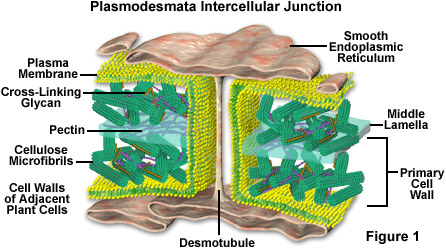Plasmodesmata
Plasmodesmata (singular, plasmodesma) are small channels that directly connect the cytoplasm of neighboring plant cells to each other, establishing living bridges between cells. Similar to the gap junctions found in animal cells, the plasmodesmata, which penetrate both the primary and secondary cell walls (see Figure 1), allow certain molecules to pass directly from one cell to another and are important in cellular communication.

The plasmodesmata is structured in an entirely different configuration than the animal cell gap junction because of the thick cell wall. Due to the presence of plasmodesmata, plant cells can be considered to form a synctium, or multinucleate mass with cytoplasmic continuity. Accordingly, the tiny channels have caused a significant amount of debate among scientists regarding cell theory, some suggesting that the cells of higher plants are not really cells at all since they are not physically separated or structurally independent from one another.
Somewhat cylindrical in shape, plasmodesmata are lined with the plasma membrane so all connected cells are united through essentially one continuous cell membrane. A majority of plasmodesmata also contain a narrow tube-like structure called the desmotubule, which is derived from the smooth endoplasmic reticulum of the connected cells. The desmotubule does not completely fill the plasmodesma and, consequently, a ring of shared cytoplasm is located between it and the inner surface of the membrane-lined channel. Plasmodesmata typically form during cell division when parts of the endoplasmic reticulum of the parent cell get trapped in the new cell wall that is produced to create daughter cells. Thousands of plasmodesmata may be formed that connect the daughter cells to one another.
It is widely thought that by constricting and dilating the openings at the ends of the plasmodesmata, plants cells regulate the passage of small molecules, such as sugars, salts, and amino acids, though this mechanism is not yet well understood. Yet, it is known that in some cases the size restrictions on molecule passage between cells can be overcome. By binding to parts of the plasmodesmata, special proteins and some viruses are able to increase the diameter of the channels enough for unusually large molecules to pass through.
